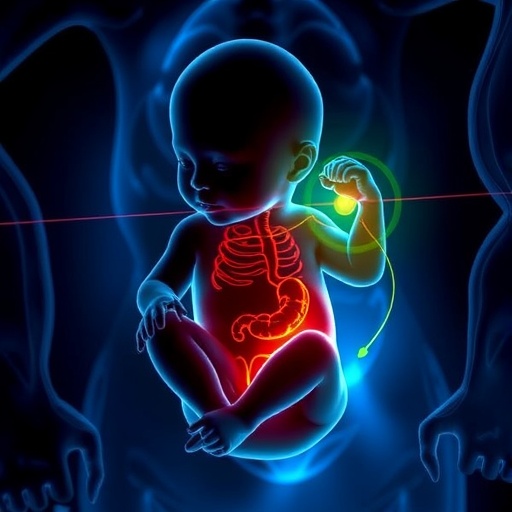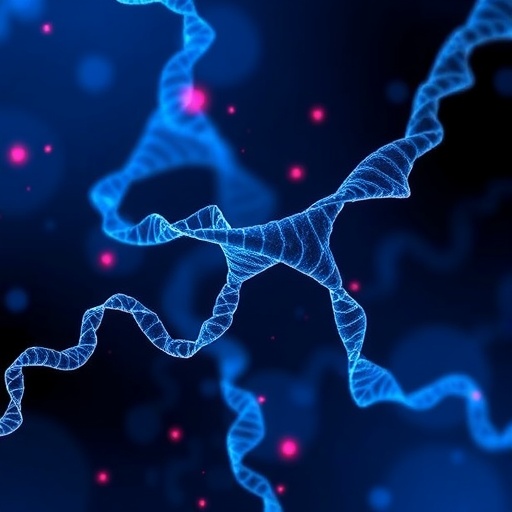
In recent years, the intricate processes driving neonatal necrotizing enterocolitis (NEC) have captivated researchers, spurring a surge of investigations into its underlying cellular mechanisms and potential therapeutic targets. A groundbreaking study published in Cell Death Discovery by Shen, Chen, and Tou (2025) has revealed an unprecedented link between ferroptosis inhibition in inflammatory macrophages and alleviation of intestinal injury in NEC. This landmark research sheds light on the complex interplay between cell death pathways and inflammatory responses in neonatal intestinal tissues, paving the way for innovative treatments that could dramatically improve outcomes for affected infants.
Necrotizing enterocolitis remains one of the most devastating gastrointestinal emergencies in neonatology, particularly impacting preterm infants. Characterized by severe inflammation, ischemia, and necrosis of the intestinal tissue, NEC poses significant morbidity and mortality risks. Despite decades of research, the pathogenesis of NEC has remained only partially understood, with multifactorial components including microbial dysbiosis, immune dysregulation, and intestinal barrier immaturity playing contributory roles. The current study dives deep into one specific cell death pathway—ferroptosis—and explores how its regulation in immune cells modulates disease progression.
Ferroptosis, a recently characterized form of regulated cell death, is distinctly iron-dependent and marked by the accumulation of lipid peroxides to lethal levels within the cell membrane. Unlike apoptosis or necrosis, ferroptosis involves unique biochemical cascades centered around iron metabolism and oxidative stress. Previous research has implicated ferroptosis in various pathological states, including neurodegeneration and cancer, but its role in inflammatory diseases and particularly in NEC has been underexplored until now.
.adsslot_DJA1TsKiQd{width:728px !important;height:90px !important;}
@media(max-width:1199px){ .adsslot_DJA1TsKiQd{width:468px !important;height:60px !important;}
}
@media(max-width:767px){ .adsslot_DJA1TsKiQd{width:320px !important;height:50px !important;}
}
ADVERTISEMENT
The investigators employed sophisticated murine NEC models combined with advanced molecular and cellular analyses to decipher the contribution of macrophage ferroptosis to intestinal injury. Macrophages are critical mediators of inflammation and tissue remodeling in the gut, able to adopt diverse functional phenotypes responding dynamically to environmental cues. In this study, macrophages undergoing ferroptosis were found to exacerbate intestinal damage by releasing pro-inflammatory signals and perpetuating oxidative stress, thereby amplifying mucosal injury during NEC.
Importantly, by pharmacologically inhibiting ferroptosis specifically in inflammatory macrophages, the researchers demonstrated a marked reduction in intestinal epithelial injury in neonatal mice, underscoring the potential of ferroptosis as a therapeutic target. The use of ferroptosis inhibitors mitigated oxidative lipid damage and suppressed the release of detrimental inflammatory mediators. This intervention not only preserved tissue integrity but also improved survival rates and clinical outcomes in NEC models, indicating a paradigm shift in how neonatal intestinal injury might be managed.
The mechanistic insights offered by Shen and colleagues elucidate how ferroptosis intersects with the immune system’s inflammatory arm in NEC pathogenesis. The team identified key regulatory molecules governing iron homeostasis and antioxidant defenses within macrophages, revealing that dysregulation at these checkpoints precipitates uncontrolled lipid peroxidation and cell death. Furthermore, macrophage polarization towards a pro-inflammatory phenotype was closely tied to heightened ferroptotic activity, suggesting that immune cell metabolic states are intimately linked with ferroptosis execution.
Intriguingly, the study also explored gene expression profiles in isolated macrophages from NEC-affected tissues, revealing upregulation of ferroptosis-associated genes such as Acsl4 and Ptgs2, alongside suppressed expression of glutathione peroxidase 4 (GPX4), a crucial ferroptosis inhibitor. This gene signature affirms the ferroptotic vulnerability of inflammatory macrophages in diseased neonatal intestines. Therapeutic modulation aimed at restoring GPX4 function or countering lipid peroxide accumulation emerged as promising strategies for curtailing intestinal damage.
The implications of these findings extend beyond neonatal necrotizing enterocolitis. As ferroptosis has been implicated in numerous inflammatory and degenerative diseases, targeting this pathway may prove a versatile approach to modulate pathological cell death in diverse clinical contexts. Particularly, the identification of macrophages as key ferroptotic effectors in NEC bridges innate immunity and cellular metabolism, offering a comprehensive framework for future immunometabolic interventions.
This study adds to a growing body of literature emphasizing the importance of regulated cell death modalities in health and disease. While apoptosis and necroptosis have long been recognized, ferroptosis represents a frontier of cell biology that merges oxidative stress, iron metabolism, and inflammation. The selective vulnerability of macrophages in NEC to ferroptosis highlights the nuanced roles different immune subsets play in disease progression and resolution.
Moreover, the translational potential of ferroptosis inhibitors is underscored by the availability of small molecule compounds capable of modulating lipid peroxidation and iron-dependent oxidative pathways. Shen et al.’s demonstration of pharmacological rescue in NEC mouse models suggests that early clinical trials targeting ferroptosis might be feasible, heralding a new era of precision medicine for neonatal intestinal disorders.
It is also worth noting that the integration of ferroptosis research with neonatal immunology enriches the conceptual understanding of NEC as a disease not solely of barrier dysfunction or microbiome alteration but one deeply intertwined with immune-metabolic dysfunction. Targeted therapies that restore macrophage homeostasis and prevent deleterious ferroptotic signaling could transform the therapeutic landscape.
Future investigations should aim to delineate the upstream triggers initiating ferroptosis in macrophages within the neonatal intestine and explore combinational treatments that include antioxidative nutrients, iron chelators, and ferroptosis inhibitors. Longitudinal studies may also illuminate how ferroptosis dynamics evolve during NEC progression and recovery, enabling timing of interventions for maximal benefit.
In conclusion, the research led by Shen, Chen, and Tou illuminates a critical axis linking ferroptosis in inflammatory macrophages to intestinal injury in neonatal necrotizing enterocolitis. By revealing both mechanistic underpinnings and therapeutic promise, this study carves a novel path forward in our quest to prevent and treat this life-threatening condition. Continued exploration of regulated cell death pathways holds vast potential to unravel the complexities of neonatal inflammation and tissue injury, ultimately improving outcomes for the most vulnerable patients.
Subject of Research: Inflammatory macrophage ferroptosis and its role in neonatal necrotizing enterocolitis intestinal injury
Article Title: Inhibition of ferroptosis in inflammatory macrophages alleviates intestinal injury in neonatal necrotizing enterocolitis
Article References:
Shen, L., Chen, J. & Tou, J. Inhibition of ferroptosis in inflammatory macrophages alleviates intestinal injury in neonatal necrotizing enterocolitis. Cell Death Discov. 11, 365 (2025). https://doi.org/10.1038/s41420-025-02665-9
Image Credits: AI Generated
DOI: https://doi.org/10.1038/s41420-025-02665-9
Tags: cell death pathways in neonatologyferroptosis inhibition in inflammatory macrophagesimmune dysregulation in preterm infantsinflammatory responses in NECinnovative therapies for intestinal injuryintestinal barrier immaturity and NEClipid peroxides and regulated cell deathmicrobial dysbiosis and NECneonatal intestinal injury treatmentneonatal necrotizing enterocolitispathogenesis of necrotizing enterocolitissevere gastrointestinal emergencies in neonates





